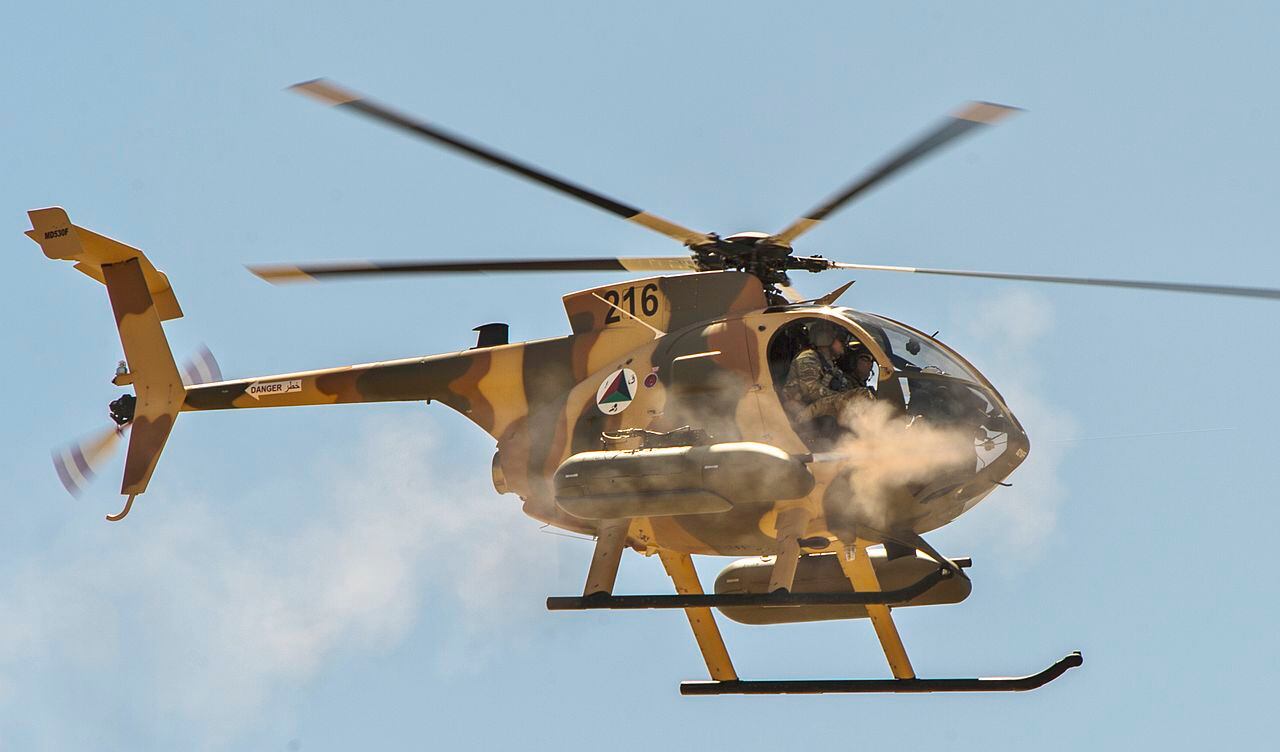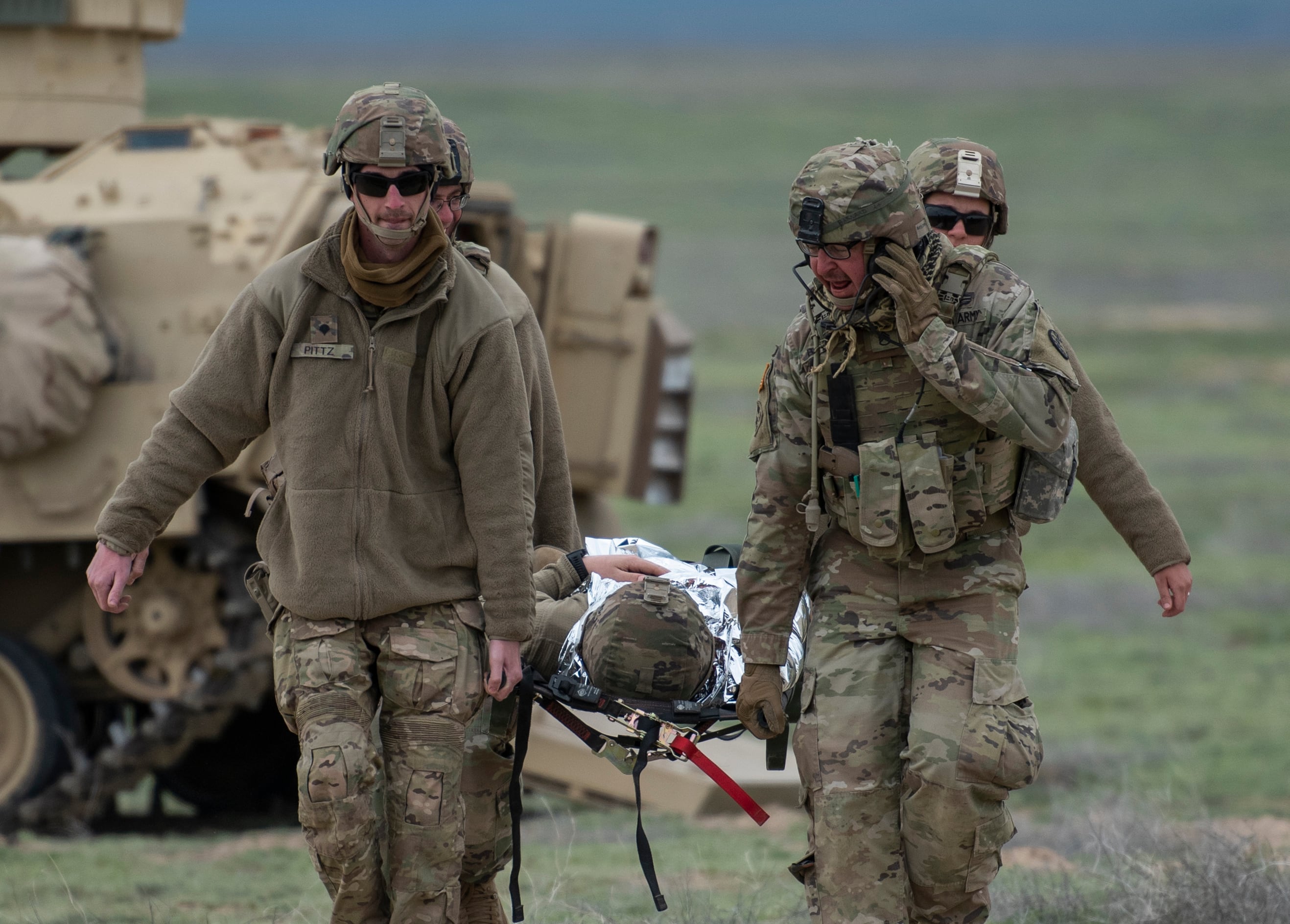As the U.S. considers sending more troops to Afghanistan, Marines in Helmand province recently showed how U.S. advisers can help Afghan security forces take the fight to the Taliban.
In June, Afghan troops and police resupplied two battalions in Marjah as part of Maiwand Three, an operation named after a major battle in the Second Anglo-Afghan War.
Although Marines did not accompany the Afghans into battle, they tracked the Afghan National Army's 215th Corps and 505th Zone National Police on the ground using surveillance aircraft, said Sgt. Maj. Darrell Carver, senior enlisted adviser for Task Force Southwest.

An Afghan Air Force Cayuse Warrior helicopter fires its machine guns during an April 9 media demonstration at a training range outside of Kabul.
Photo Credit: Staff Sgt. Perry Aston/Air Force
"We helped get their air assets to support them," Carver told Marine Corps Times in an interview. "We were able to see the enemy as they were engaging the [Afghan National Army and Afghan National Police] forces as they moved for the operations. Our air advisers and our artillery advisers were able to help shape the battlefield — or at least get them oriented on these targets — so that they could utilize their own assets."
Using their own D-30 howitzers, MD-530 attack helicopters and Mi-17 transport helicopters, Afghan security forces successfully opened ground routes to Marjah and evacuated their wounded to hospitals, he said.
"It showed that the 215th Corps and 505th Zone had the ability to move anywhere they wanted, when they wanted to be able to resupply and to support their forces that are in what most people consider to be Taliban-controlled area," Carver said.
The operation marked another milestone: The 215th Corps was the only Afghan unit that performed Corps-level operations during the month of Ramadan, said Maj. Kenda Motz, a spokeswoman for Task Force Southwest.
The roughly 300 Marines in Helmand are among the more than 8,400 U.S. troops now in Afghanistan, said Navy Capt. Bill Salvin, a spokesman for Operation Resolute Support. Of those troops, 6,750 are part of the NATO-led mission to advise and assist Afghan security forces and 2,150 troops are part of the U.S. anti-terrorism mission, he said. Another 400 "over-the-horizon troops" made up of administrative and logistics staff contribute to both missions.
The current security situation in Helmand province is precarious, said Michael Kugelman of the Woodrow Wilson International Center for Scholars, a think tank in Washington. In March the Taliban captured Sangin, where nearly 50 Marines have been killed during years of fighting, but the insurgents have been unable to capture any more entire districts since then, he said.
"On the one hand, there are encouraging signs in that Afghan forces have made some major progress against the Taliban on the battlefield," Kugelman told Marine Corps Times. "On the other hand, the Taliban continues to control several districts and ample territory, especially in rural areas. It also enjoys the ability to stage horrific mass-casualty attacks, like an attack near a bank in the provincial capital some days back."
It is too early to tell whether the Marines in Helmand have made a major impact since assuming the advise-and-assist mission in late April, he said.
"At this point, the key is for U.S. forces to be renewing relationships with key powerbrokers in the province," Kugelman told Marine Corps Times. "You need those relationships to be solid, which in turn will raise the chances of success in terms of efforts to help Afghan forces on the battlefield. I know that the relationship-building aspect has been a major priority for US forces in Helmand, and that's a good thing."
The key to success in Helmand and elsewhere in Afghanistan is having Marines and other U.S. troops go into the field with Afghan forces, he said.
"So I think if we're looking at impact measurements for the advise-and-assist mission in Helmand, we'll need to be looking for signs that American forces are out there in the field advising the Afghan troops, and not just getting restricted to bases," Kugelman said.
Defense Secretary James Mattis is considering sending up to 4,000 extra trainers to Afghanistan, according to reports, but retired Army Gen. Jack Keane said he believes the U.S. needs to rotate Army and Marine Corps combat units to Afghanistan to reverse the Taliban's gains.
Keane speaks from experience: In December 2006, he told then-President Bush that the U.S. strategy in Iraq was not designed to defeat the insurgency. Shortly thereafter, Bush named Gen. David Petraeus the overall U.S. commander in Iraq to oversee the surge.
The security situation in Afghanistan is so dire that the U.S. should immediately send Marine infantry battalions along with Ranger battalions and other Army units to fight alongside Afghan security forces, said Keane, who served as Army vice chief of staff from 1999 to 2003. Those units would spend up to 90 days in country, helping Afghan troops and police to push the Taliban back, he said.
"It would be a huge morale boost to the Afghan security forces to start knocking this thing down and getting some momentum," Keane told Marine Corps Times. "I don't know how long that would last — maybe two fighting seasons at the most."
Although Afghan troops and police are courageous fighters, they are essentially an infantry force that lacks the intelligence, logistics, medevac and other capabilities needed to beat the Taliban, he said. The Afghans had relied on the U.S. military to detect roadside bombs, but since the end of the U.S. combat mission there, the numbers of Afghans killed and wounded by such bombs have soared.
If the U.S. does nothing, the Taliban will continue to bleed the Afghan security forces white until they break the will of Afghan troops and police to fight, he said.
"As a matter of strategy, I'm asking myself: Can we really turn the momentum around with a few thousand additional advisers and trainers?" Keane said. "I think not, if we don't provide the Afghans the enablers that they need to fight effectively and if we don't do some fighting early on, side-by-side, with some U.S. forces for a limited amount time with limited numbers."




